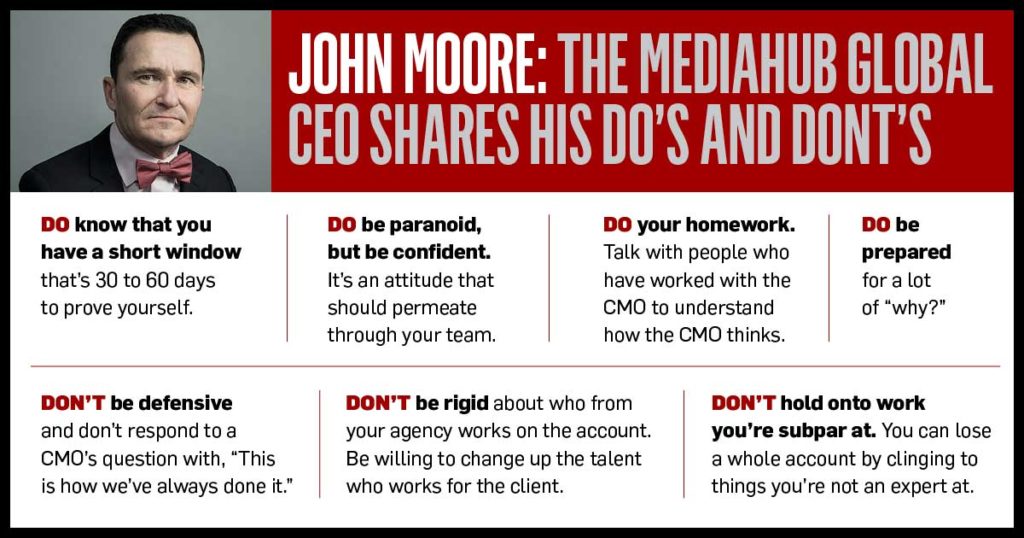Execs with longstanding client relationships give advice on withstanding disruption
With each passing year, CMO tenures get shorter. According to the latest Spencer Stuart survey, chief marketing officers are staying in their roles for only 40 months and among the top 100 advertisers in the U.S., the median tenure is just 25.5 months. Each new CMO brings new priorities—and often new agency partners.
“When a new CMO comes in, you have to understand the change is coming,” said John Moore, global CEO of Mediahub. But for many of the agency leaders Adweek spoke with for this story, including Moore, a CMO change is an opportunity for the agency to put itself in a better place. Based on that CMO’s history or their directive when they take the reins, a new CMO can almost certainly guarantee an account is going up for review.
When that’s not the case, agency chiefs often see it as an opportunity to reassess the relationship: what’s working and what’s not, who should work on the account and in some cases whether the account is even worth holding onto.
“There’s two mentalities: when it happens, there’s that initial fear or there’s that initial perverted excitement,” said Howie Kleinberg, president of Glow, who has navigated complete C-Suite turnovers at clients, including the Westminster Dog Show—a client of eight years.
“We usually lean toward perverted excitement because, ‘wow, this could be fantastic and an opportunity to build on this relationship.’”
Here are the steps agency leads take in order to shore up an account to ensure they are irreplaceable:
Building a new relationship
Ultimately CMOs want to succeed—whether they’re replacing someone who left for a new opportunity or have been hired to usher in new thinking—and so they’re looking for allies, said Stacie Boney, president of independent agency Hanson Dodge. That means embracing the new and learning what success looks like to that CMO.
Boney tries to break bread with the new CMO as quickly as possible to not just learn about their goals, but get to know them personally and also understand the CMO’s pet peeves with past agency partners.
Marcus Collins, head of planning for Wieden+Kennedy New York, described it as being “radically empathetic” toward the new CMO. They’re facing the same pressures as the agency, so Collins likes to ensure the new CMO that they’re here to support them as a pool of knowledge that he or she can tap into.
“By being empathetic, focusing on the business and the CMO, that creates a shared vision we can all subscribe to and those are the things that can fortify a relationship as things change.” Collins said.
Kleinberg stressed the importance of making that first call immediately. He gave an example of a client with many agencies on its roster that experienced executive turnover. His agency retained the client after the executive team highlighted that not only was it the only agency to prepare a SWOT (Strengths, Weaknesses, Opportunities and Threats) analysis for the client, as Kleinberg typically does for new CMOs he works with, but because it was the only agency to reach out to the new leader.
Preparing your agency for what’s next
CMOs are often walking into situations where a lot needs to be addressed or undone. Agencies, therefore, have a short window to show they can drive change to support the new CMO’s agenda and to not be a reflection of the brand’s bad habits.
When Mediahub’s Moore experienced a CMO change at a client, he said his team made a pact with the corresponding creative agency to show the client how the two work together.
“CMOs hate when they’re herding cats,” Moore said, adding that it made it easier for the new CMO to navigate the agencies they inherited, but also allowed Mediahub to show how the two agencies were intertwined together and delivered results for the brand.

Boney’s approach is to clearly define the situation for her employees. She creates a short doc or presents a keynote to explain opportunities and risks in order to help everyone understand what a new leader at a client could mean for them.
“The farther away the people in the organization get from the senior leadership at the client, the more worried they can become,” said Nannette Lafond-Dufour, president, global clients and business leadership at McCann. McCann, which has held onto clients like Nestlé, GM, Coca-Cola and L’Oréal for decades, communicates to employees what the agency network is doing across all levels of the company to ensure the relationship is stable so that employees can focus on work and not the politics with an account’s status.
Marcus Collins takes a similar approach, emphasizing the education of junior staffers to help them better understand the realities of the business.
Becoming irreplaceable
“Brand building is a long term game,” Lafond-Dufour said. She argues that if a new CMO is considering significant change, that could mean walking away from an agency that understands the brand’s customers and how to best reach them.
“The contemporary agency relationship is not as transient anymore because it’s not just about a campaign or an idea,” said the CEO of a global agency within one of the major holding companies, asking to remain anonymous. Another way agencies can make themselves indispensable: become the gatekeeper of the brand’s voice instead of letting that role be handled internally. The agency needs to be the brand’s secret sauce, not a cog in the machine.
As marketing functions continue to be elevated in the C-Suite, it’s important to build relationships with more than just the CMO. Being integrated more deeply in a brand means working closing with the head of sales, the chief revenue officer, the chief digital officer and, in many cases, the CEO, said the New York-based agency executive.
Mediahub’s John Moore doesn’t stop at holding calls with just the CMO; he hosts periodic check-ins with his clients’ top marketing managers to bolster relationships. “Make sure that you show everybody love in the organization, and not just the CMO, because that can come back to haunt you a little bit,” Moore said.
One agency leader Adweek spoke with hammered home the importance of building relationships across the team. For one client, the agency didn’t form strong relationships with other top members of the marketing team. When the CMO, who was able to mitigate those weak bonds, departed the relationship deteriorated under the new CMO and the agency lost the account.
…
This article first appeared in www.adweek.com
Seeking to build and grow your brand using the force of consumer insight, strategic foresight, creative disruption and technology prowess? Talk to us at +971 50 6254340 or mail: engage@groupisd.com or visit www.groupisd.com/story




